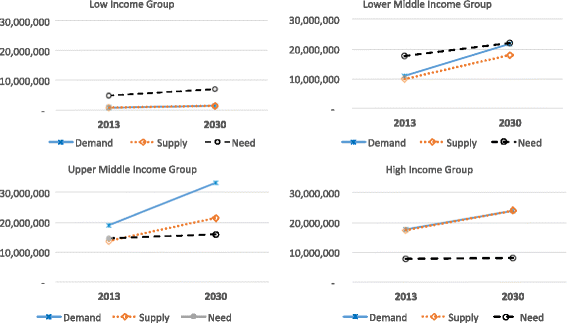Global Health Workforce Labor Market Projections for 2030
- PMID: 28159017
- PMCID: PMC5291995
- DOI: 10.1186/s12960-017-0187-2
Global Health Workforce Labor Market Projections for 2030
Erratum in
-
Erratum to: Global Health Workforce Labor Market Projections for 2030.Hum Resour Health. 2017 Feb 20;15(1):18. doi: 10.1186/s12960-017-0193-4. Hum Resour Health. 2017. PMID: 28219409 Free PMC article. No abstract available.
Abstract
Background: In low- and middle-income countries, scaling essential health interventions to achieve health development targets is constrained by the lack of skilled health professionals to deliver services.
Methods: We take a labor market approach to project future health workforce demand based on an economic model based on projected economic growth, demographics, and health coverage, and using health workforce data (1990-2013) for 165 countries from the WHO Global Health Observatory. The demand projections are compared with the projected growth in health worker supply and the health worker "needs" as estimated by WHO to achieve essential health coverage.
Results: The model predicts that, by 2030, global demand for health workers will rise to 80 million workers, double the current (2013) stock of health workers, while the supply of health workers is expected to reach 65 million over the same period, resulting in a worldwide net shortage of 15 million health workers. Growth in the demand for health workers will be highest among upper middle-income countries, driven by economic and population growth and aging. This results in the largest predicted shortages which may fuel global competition for skilled health workers. Middle-income countries will face workforce shortages because their demand will exceed supply. By contrast, low-income countries will face low growth in both demand and supply, which are estimated to be far below what will be needed to achieve adequate coverage of essential health services.
Conclusions: In many low-income countries, demand may stay below projected supply, leading to the paradoxical phenomenon of unemployed ("surplus") health workers in those countries facing acute "needs-based" shortages. Opportunities exist to bend the trajectory of the number and types of health workers that are available to meet public health goals and the growing demand for health workers.
Keywords: Global health; Health workforce; Labor market projections.
Figures


References
-
- United Nations General Assembly. Transforming Our World: The 2030 Agenda for Sustainable Development [Internet]. United Nations; 2015 [cited 2015 Oct 10]. Available from: http://www.un.org/ga/search/view_doc.asp?symbol=A/70/L.1&Lang=E
-
- Campbell J, Dussault G, Buchan J, Pozo-Martin F, Guerra Arias M, Leone C, et al. A universal truth: no health without a workforce [Internet]. Geneva: Global Health Workforce Alliance and World Health Organization; 2013 [cited 2015 Feb 1]. Available from: http://www.who.int/workforcealliance/knowledge/resources/hrhreport2013/en/.
MeSH terms
LinkOut - more resources
Full Text Sources
Other Literature Sources
Medical

